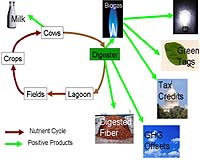 |
Indianapolis IN (SPX) Oct 09, 2009 For the last five years, Madison County farmer Mike Shuter has maintained the same crop rotation on his farm of two-thirds of his fields in corn and one-third in soybeans. He hasn't seen the need to increase his corn acres even with the evolution of the biofuels industry and its need for corn. This seems to be the trend across the state. Indiana farmers planted 5.7 million acres of corn in both 2008 and 2009, down from 6.5 million acres in 2007. The majority of Indiana farmers plant corn and soybeans in a two-year rotation, unlike farmers in the Western Corn Belt where you see a more continuous corn environment. "The assumption that farmers are going to increase corn acres because of increased ethanol production has not and will not ring true," said Shuter, who serves as president of the Indiana Corn Marketing Council. At the same time as farmers across the country reduced the number of corn acres planted, U.S. ethanol production increased from 6.5 billion gallons per year in 2007 to more than 9 billion gallons last year. As harvest kicks into full gear around the state, Indiana farmers are expected to produce 30 bushels more corn per acre than they did just 10 years ago. In fact, there are about the same number of corn acres in Indiana this year as in 1999, but farmers are expected to produce more than 150 million more bushels on those same acres. The trend of significant gains in yields is expected to continue. Forecasts show that over the next five years corn yields are expected in increase to 174 bushels per acre, more than 20 bushels better than the average in 2007. "Looking at the long-term demand for corn, these increased yields translate into enough corn to supply all markets," said Shuter. Over the next five years, the anticipated trends in livestock production, food, ethanol and exports all point to having the same amount of corn left at the end of each year as we do today. "There is an amazing story taking shape in our farm fields across the state," said Mark Henderson, Executive Director of the Indiana Corn Marketing Council. "At the same time as farmers are becoming better at producing more corn on less land, they continue to be good stewards of the land as many of the land management practices already being used by farmers across the state have shown significant results." In 2007, 27 percent of the corn acres planted in Indiana were managed in a no-till system. In comparison, only 9 percent of corn acres were no-tilled in 1990. The adoption of no-till and other conservation tillage practices from 1990 to 2007 has led to significantly less soil loss across the state from farm fields. Since 1980, input utilization per bushel of corn produced in the United States has reduced significantly, including 40 percent decrease in nitrogen, 45 percent decrease in phosphorus and 50 percent decrease in potash. Since 1977, the energy used to produce a bushel of corn has decreased 37 percent. "Indiana farmers know that stewardship of the environment is the key to continued viability of agriculture for generations to come. Our farmers utilize conservation practices to keep soil and nutrients on their fields where crops can flourish and out of our waterways," said Anne Hazlett, Director of the Indiana State Department of Agriculture (ISDA). "These practices protect our environment by addressing site-specific needs to prevent sediment loss into our waterways." Shuter, who farms with his two sons - Patrick and Brian, has been using strip tillage on all of his corn acres for the last five years. Strip tillage is a system combining the benefits of no-till and full-width tillage where tillage is confined to narrow strips where seeds will be planted. "We are leaving more residue on the surface of our fields and seeing less erosion," said Shuter. "I feel like we are doing a better job producing corn while reducing sediments and keeping valuable nutrients such as nitrogen and phosphorous in the fields and out of streams and other bodies of water." Share This Article With Planet Earth
Related Links Indiana Corn Marketing Council Bio Fuel Technology and Application News
 Nevada's First Biodigester Starts Construction
Nevada's First Biodigester Starts ConstructionYerington NV (SPX) Oct 09, 2009 Desert Hills Dairy Biodigester has begun plans and acquired land to construct the first biodigester in the State of Nevada at Desert Hills Dairy in Wabuska, near Yerington, Nevada. The biodigester will capture methane from the effluent from dairy cattle to generate clean electrical energy, highly nutritious and non-toxic liquid fertilizer, a mulch by-product and enough power to run both ... read more |
|
| The content herein, unless otherwise known to be public domain, are Copyright 1995-2009 - SpaceDaily. AFP and UPI Wire Stories are copyright Agence France-Presse and United Press International. ESA Portal Reports are copyright European Space Agency. All NASA sourced material is public domain. Additional copyrights may apply in whole or part to other bona fide parties. Advertising does not imply endorsement,agreement or approval of any opinions, statements or information provided by SpaceDaily on any Web page published or hosted by SpaceDaily. Privacy Statement |